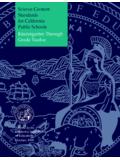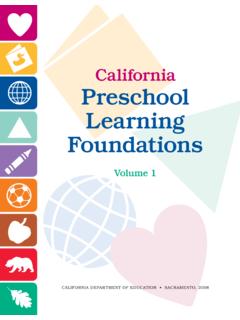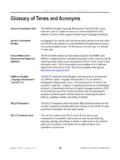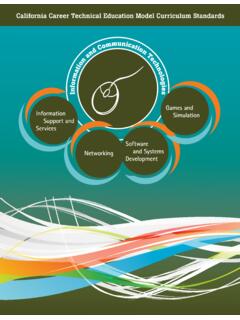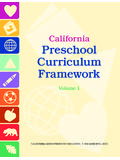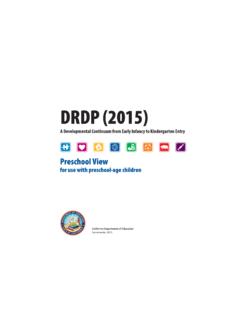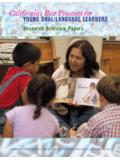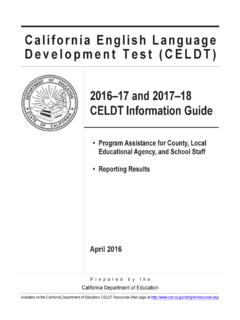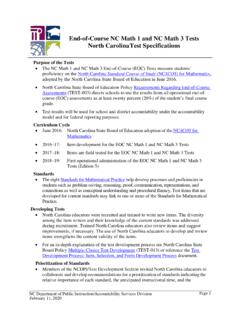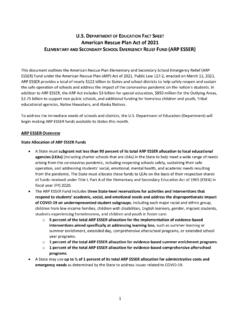Transcription of California Preschool Program Guidelines
1 California Preschool Program Guidelines California department of education Sacramento, 2015 California Preschool Program Guidelines Publishing Information California Preschool Program Guidelines was prepared under the direction of the Early education and Support Division, California department of Educa-tion. This publication was edited by Faye Ong and John McLean, working in cooperation with Laura Bridges, Child Development Consultant. It was designed and prepared for printing by the staff of CDE Press, with the cover and interior design created and prepared by Karen Phillips. It was published by the department of education , 1430 N Street, Sacramento, California 95814. It was distributed under the provisions of the Library Distribution Act and Government Code Section 11096. 2015 by the California department of education All rights reserved ISBN 978-0-8011-1750- Reproduction of this document for resale, in whole or in part, is not authorized.
2 Ordering Information Copies of this publication are available for purchase from the California Depart-ment of education . For prices and ordering information, please visit the Depart-ment Web site at or call the CDE Press sales RI FH DW Notice The guidance in California Preschool Program Guidelines is not binding on local educational agencies or other entities. Except for the statutes, regulations, and court decisions that are referenced herein, the document is exemplary, and compliance with it is not mandatory. (See education Code Section ) Contents A Message from the State Superintendent of Public Acknowledgments ..viii xii Setting the Stage for Program Quality Part One Chapter 1 Current Issues in Early Childhood education ..3 General 3 Evidence from Research.
3 3 The Need for High-Quality Preschool programs ..5 Early Childhood Investments and Societal Recent Research on Brain Development .. 6 School Readiness .. 10 The California Context .. 11 Readiness Gap .. 12 Desired Results for Children and Families .. 12 Overview of Preschool Learning Foundations .. 15 Closing Thoughts .. 15 References .. 16 Chapter 2 The Preschool The Five Essential Domains of School Social Emotional Development .. 24 Language and Literacy.
4 24 Cognition and General Knowledge .. 26 Physical Well-Being and Motor Development .. 29 Approaches Toward Learning .. 31 The Role of Play in Children s Learning and Development ..32 Closing Thoughts .. 33 References .. 34 Further Reading .. 35 Chapter 3 The Role of the Preschool Teacher ..39 Build and Maintain Positive Relationships with Children ..39 Build and Maintain Positive Relationships with Families .. 40 Create an Environment for Social and Emotional Learning ..41 Be Responsive to Children s Linguistic and Cultural Experiences .. 42 iii 1 Include Children with a Wide Range of Abilities and Approaches to Learning.
5 42 Understand Children s Needs and Capabilities .. 43 Plan the Learning Environment and Curriculum in the Domains of School Readiness .. 44 Balance Child-Initiated and Teacher-Initiated 45 Assess How Well the Program Meets Children s Needs .. 46 Closing Thoughts .. 48 References .. 48 Further Reading ..48 Chapter 4 The Role of the Administrator ..51 Reflective Curriculum Planning ..53 Setting the Conditions for Work .. 56 Creating a Collaborative Work Environment and Learning Integrating Reflective Practice, Reflective Supervision, and Accountability to Maintain Program Quality.
6 61 Closing Thoughts .. 62 References .. 63 Further Reading ..64 Part Two Supporting Young Children s Learning and Development Chapter 5 Use of the California Preschool Curriculum Integrated Curriculum for Young Dual Language Learners .. 69 Universal Design ..70 The Curriculum Planning Process .. 70 Closing Thoughts .. 73 References .. 74 Further Reading.
7 74 Chapter 6 Support for Young Dual Language Guiding Principles for Supporting Young Dual Language Learners .. 76 Characteristics of Preschool Dual Language Learners .. 76 Program Approaches and Teaching Practices .. 80 Assessment of Young Dual Language Learners .. 87 Family Engagement .. 87 Inclusion of Young Dual Language Learners Who Have Special Needs .. 88 Support for the Transition to Kindergarten ..89 Early Childhood Educator Closing Thoughts .. 90 References .. 91 Further Reading ..91 iv 65 Chapter 7 Using Technology and Interactive Media with Preschool -Age Children.
8 93 Children and Electronic Media .. 93 Technology and Interactive Media in the Preschool Environment .. 94 The Benefits and the Challenges of Using Technology and Interactive Media .. 95 Selecting Technology and Interactive Media to Enhance Children s Learning .. 97 Integrating and Using Technology in the Preschool Environment .. 99 Training and Professional Development Opportunities .. 101 References .. 101 Further Reading .. 103 Part Three Program Guidelines 105 Chapter 8 Guidelines for Operating Preschool 107 Guideline 1: Aspiring to Be a High-Quality Program .. 107 Guideline 2: Addressing Culture, Diversity, and Equity .. 115 Guideline 3: Supporting Relationships, Interactions, and Guidance.
9 122 Guideline 4: Engaging Families and Communities .. 130 Guideline 5: Including Children with Disabilities or Other Special Needs .. 141 Guideline 6: Promoting Health, Safety, and Nutrition .. 155 Guideline 7: Assessing Children s Development and Learning .. 161 Guideline 8: Planning the Learning Environment and Curriculum .. 169 Guideline 9: Supporting Professionalism and Continuous Learning .. 185 Guideline 10: Administering programs and Supervising Staff .. 196 Appendixes 207 Appendix A: Resources for Early Care and education programs .. 209 Appendix B: Books and Media on Early education by the California department of education .. 217 Appendix C: California Preschool Children Enrolled in Special education .. 220 Appendix D: Desired Results for Children and Families.
10 221 Appendix E: State and Federal Laws Regarding People with Disabilities .. 224 Appendix F: Summary of the California Preschool Program Guidelines .. 227 Appendix G: Resources on Early Childhood Inclusive Practice .. 228 Appendix H: Member of the Class: Teachers Guide .. 234 Appendix I: Effective Strategies for Observing Children s Learning and Behavior .. 235 Appendix J: Child Development Permit Matrix .. 237 Appendix K: NAEYC Code of Ethical Conduct and Statement of Commitment .. 238 Glossary 247 v A Message from the State Superintendent of Public Instruction I am pleased to present the California Preschool Program Guidelines , a critical publi cation providing administrators, teachers, and college instructors with guidance on the essential elements of high-quality Preschool programs .
